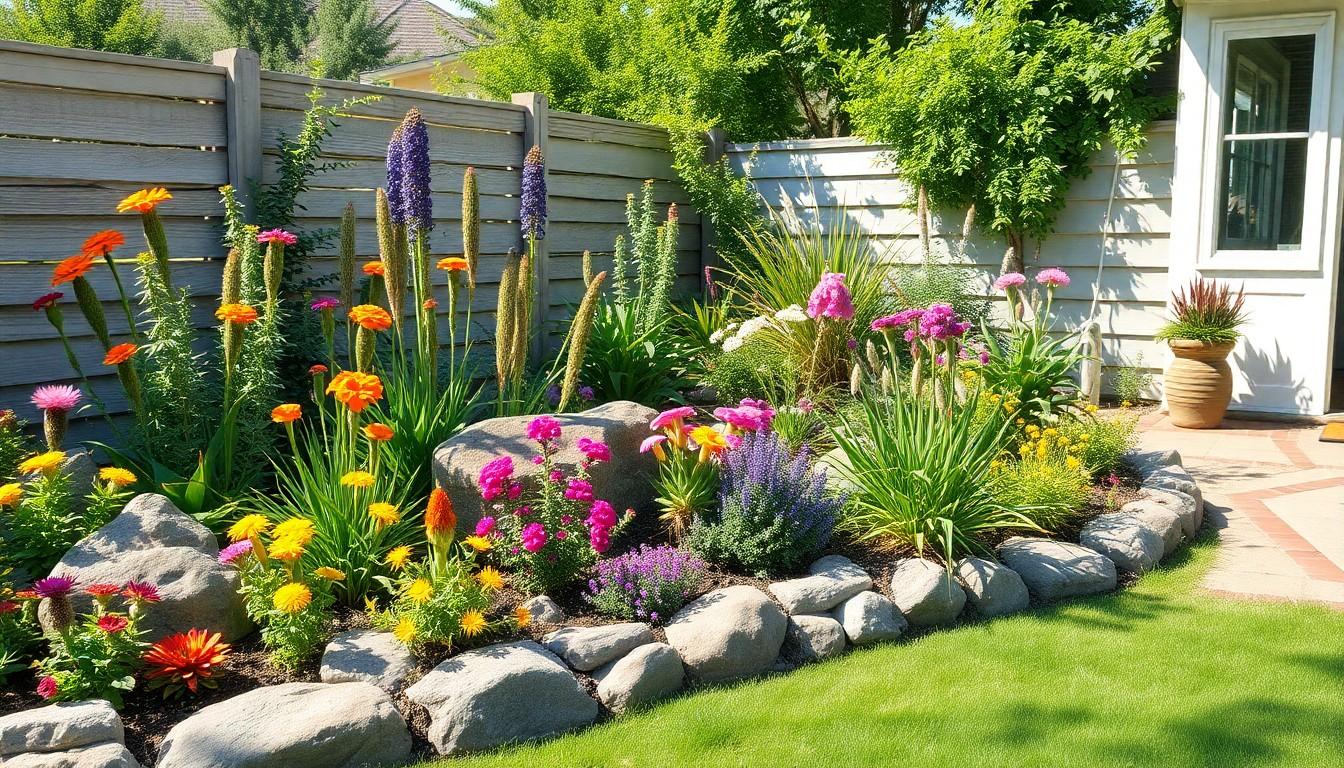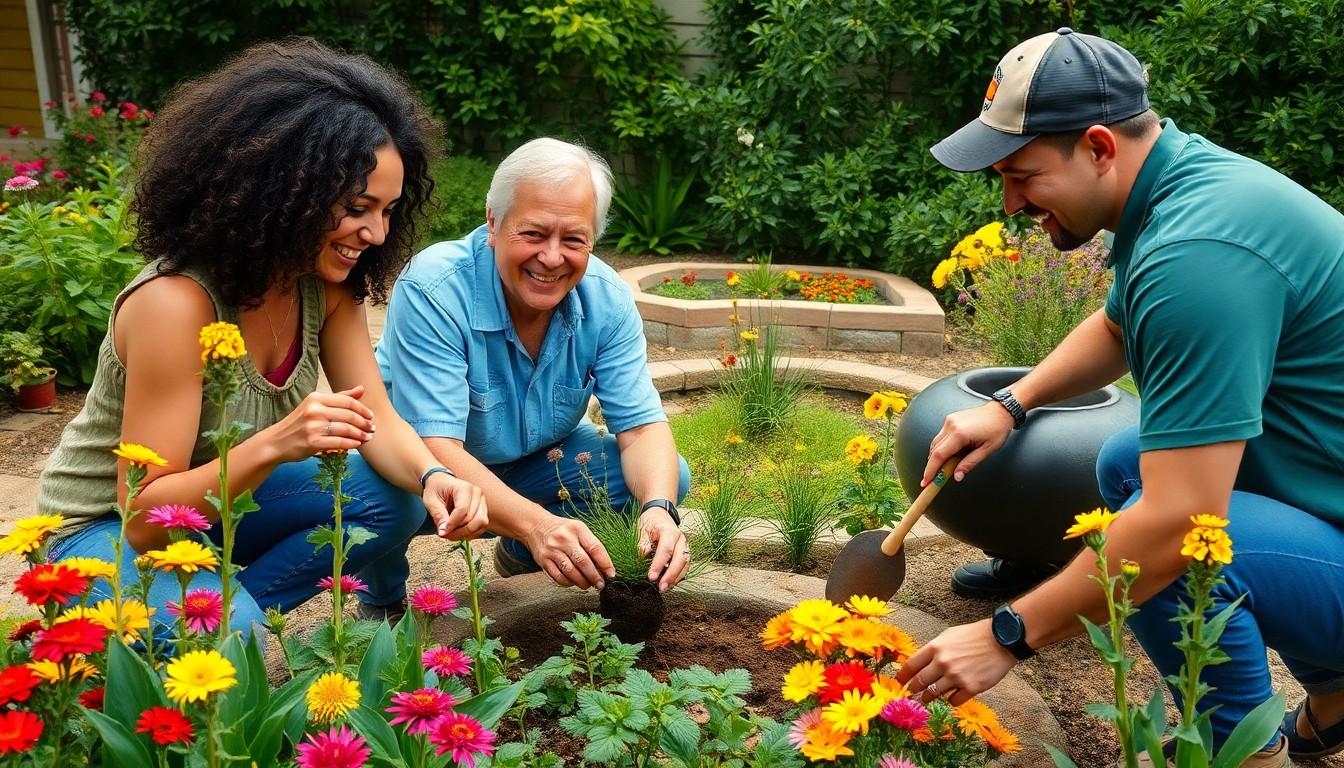Imagine stepping into your backyard and feeling like you’ve just entered a lush paradise, all while giving Mother Nature a high-five. Eco-friendly landscaping methods not only transform outdoor spaces into stunning havens but also help save the planet—one flowerbed at a time. Who knew that creating a beautiful yard could come with such a hefty dose of environmental benefits?
Eco Friendly Landscaping Methods
Eco-friendly landscaping methods focus on sustainable practices that enhance environmental health and aesthetic value. These techniques emphasize native plant selection to support local ecosystems. Incorporating drought-resistant plants reduces water consumption, promoting conservation efforts.
Using organic fertilizers and pest control methods minimizes chemical runoff into soil and waterways. Implementing composting systems not only enriches garden soil but also diverts organic waste from landfills. Landscape design can include rain gardens that capture stormwater, helping to prevent erosion and improve water quality.
Mulching offers numerous benefits, such as moisture retention, weed suppression, and temperature regulation for plants. Creating habitats for pollinators like bees and butterflies supports biodiversity and encourages natural pest control. Focusing on hardscaping with permeable materials allows rainwater absorption, preventing runoff and aiding groundwater recharge.
Soil health plays a crucial role in sustainable landscaping practices. Utilizing cover crops enriches soil and prevents erosion, while crop rotation or plant rotation maintains soil fertility. Practicing xeriscaping, particularly in arid areas, minimizes water use through efficient garden design.
Taking advantage of technologies such as rainwater harvesting systems can significantly increase water efficiency. Combining these methods leads to a vibrant, low-maintenance landscape that appeals to homeowners and supports environmental stewardship.
Benefits of Eco Friendly Landscaping

Eco-friendly landscaping offers multiple benefits, enhancing outdoor spaces while supporting the environment. These benefits extend to improving ecological health, enhancing aesthetics, and promoting sustainability.
Environmental Impact
Eco-friendly landscaping significantly reduces pollution. Implementing methods like composting and organic pest control minimizes chemical runoff into local waterways. Native plants contribute by supporting local wildlife populations and biodiversity. Sustainable practices also help conserve resources, including water, through techniques like xeriscaping. Creating rain gardens captures stormwater, reducing runoff and improving water quality. Additionally, improving soil health through organic matter increases the soil’s water retention capacity, further promoting sustainability and reducing erosion.
Aesthetic Value
Aesthetic appeal thrives in eco-friendly landscaping. Native plants, tailored to local climates, provide vibrant changes throughout the seasons. Diverse plant selections create visually stunning landscapes that attract pollinators like butterflies and bees. Using drought-resistant plants not only ensures beauty during dry spells but also maintains lushness with minimal water. Incorporating natural materials like stone and wood enhances the landscape’s charm while creating a harmonious connection with nature. Overall, combining these elements fosters an inviting outdoor space that stands out while promoting ecological balance.
Popular Eco Friendly Landscaping Techniques
Eco-friendly landscaping techniques enhance outdoor spaces while promoting environmental health. Specific methods play a significant role in creating sustainable and aesthetically pleasing gardens.
Native Plant Gardening
Native plant gardening focuses on using species that naturally thrive in local ecosystems. Selecting these plants supports local wildlife by providing essential food and habitat. These plants often require less water and maintenance, reducing the need for chemical fertilizers and pesticides. Local flora promotes biodiversity and encourages pollinators. Additionally, incorporating native plants ensures that landscapes blend harmoniously with the surrounding environment. They contribute to soil health by reducing erosion and improving nutrient cycling.
Xeriscaping
Xeriscaping involves designing landscapes that require minimal water. This technique is particularly beneficial in arid regions where water conservation is crucial. Utilizing drought-tolerant plants reduces reliance on irrigation systems. Grouping plants with similar water needs optimizes moisture usage. Incorporation of mulch helps retain soil moisture and suppress weeds. Proper planning of plant placement enhances natural shade and reduces evaporation. With this approach, homeowners can create beautiful gardens that thrive despite limited water resources.
Organic Gardening Practices
Organic gardening practices prioritize environmental health through the avoidance of synthetic chemicals. Utilizing organic fertilizers enhances soil quality while supporting beneficial microorganisms. Crop rotation improves soil fertility and reduces pest populations. Natural pest control methods such as companion planting and beneficial insects minimize the use of harmful pesticides. Implementing composting practices enriches soil quality and recycles organic waste. By adopting these methods, gardeners cultivate vibrant landscapes that contribute positively to the ecosystem.
Implementing Eco Friendly Landscaping
Eco-friendly landscaping incorporates sustainable techniques that enhance both aesthetics and environmental health. Specific methods promote a balanced ecosystem while creating beautiful outdoor spaces.
Planning Your Space
Begin with a layout that respects the natural contours of the land. Incorporating features that promote water flow helps manage runoff and encourages natural habitats. Creating designated areas for native plants and gardens improves biodiversity. In addition, planning for sunlight exposure will optimize growth for chosen flora. Allocate space for pathways that reduce soil compaction and allow for easy access without disturbing plant life. Engaging in thoughtful design ensures a thriving outdoor environment.
Choosing the Right Plants
Opt for native plants that flourish in the local climate. Selecting species adapted to the area supports local wildlife and minimizes water requirements. Drought-resistant plants reduce water usage while adding visual appeal. Combining a variety of plants with different blooming times enhances seasonal interest. Incorporating ground covers decreases weed growth and helps retain soil moisture. Creating a diverse plant palette increases resilience against pests and diseases.
Maintenance Tips
Implementing eco-friendly practices simplifies upkeep while enhancing sustainability. Watering in the early morning minimizes evaporation and maximizes water uptake. Applying organic mulch around plants retains moisture and suppresses weeds. Regularly monitoring for pests and diseases allows for prompt intervention with natural methods. Adopting composting practices enriches soil quality without chemical fertilizers. Embracing these maintenance tips fosters a healthy landscape that thrives on minimal intervention.
Case Studies of Successful Eco Friendly Landscapes
Numerous projects demonstrate the effectiveness of eco-friendly landscaping methods in various environments. One notable case is the High Line Park in New York City. Originally an abandoned railway, it transformed into a green space that uses native plantings, provides habitats for wildlife, and promotes biodiversity.
The Wisconsin Institute for Discovery serves as another exemplary model. Its landscape design emphasizes stormwater management with rain gardens and permeable pavements. This approach mitigates flooding while enhancing aesthetic appeal, showcasing how sustainability and beauty coexist.
In California, the California Academy of Sciences created a green roof featuring drought-tolerant plants. This roof not only reduces energy costs but also provides a habitat for local wildlife. By integrating natural materials, the project fosters a connection between visitors and the surrounding ecosystem.
Klyde Warren Park in Dallas boasts a unique urban design that incorporates eco-friendly elements. The park includes native gardens, water-saving irrigation systems, and education programs on sustainable landscaping. This community engagement promotes awareness of ecological practices while enhancing overall green space.
The Denver Botanic Gardens also offer extensive examples of eco-friendly landscaping. This institution showcases xeriscaping alongside native plant exhibits, providing visitors with practical ideas for their gardens. Each installation stresses the importance of water conservation and biodiversity.
Lastly, the Blue Hill Foundation in Massachusetts illustrates how sustainable design can enhance local agriculture. The foundation’s landscape features permaculture techniques, promoting soil health while producing food. This case highlights how eco-friendly landscapes can support both ecological benefits and community needs.
These case studies highlight the effectiveness of eco-friendly landscaping by providing insights into practical applications and successful outcomes across diverse environments. Each showcases how sustainable practices not only enhance gardens but foster a healthier planet.
Healthy and Resilient
Embracing eco-friendly landscaping methods not only enhances the beauty of outdoor spaces but also plays a crucial role in environmental preservation. By prioritizing sustainable practices like native planting and water conservation, homeowners can create vibrant landscapes that thrive while supporting local ecosystems.
These techniques foster a deeper connection with nature and promote biodiversity, ensuring that outdoor spaces remain healthy and resilient. As more individuals adopt these practices, the collective impact can lead to a greener planet for future generations. Investing in eco-friendly landscaping is a step towards a sustainable lifestyle that benefits both people and the environment.

